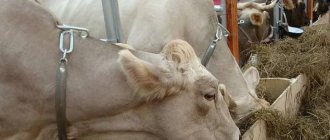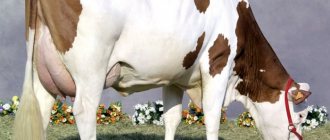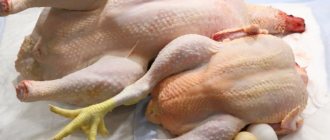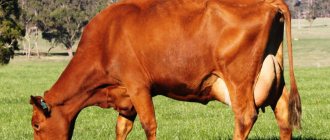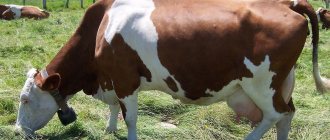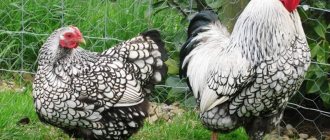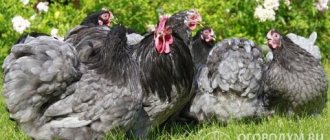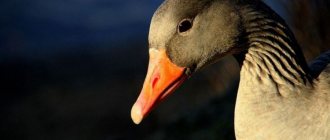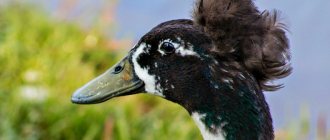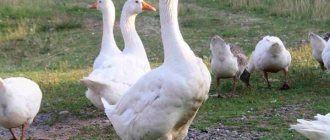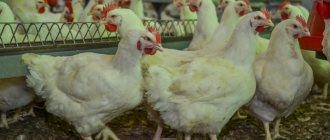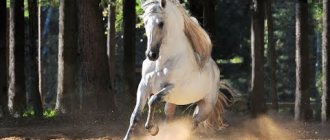Origin story
Photo:
The Jersey breed was bred in England on the island of Jersey by improving local Norman and British cattle and selecting them for fat and milk content.
In 1789, local authorities passed a law prohibiting the import of breeding stock, and thereafter the breed was maintained in purebred condition. During breeding, inbreeding was widely used, as a result of which a delicate, dry, and often overdeveloped constitution was established in the breed.
In 1866, a studbook of Jersey cattle was established, the first volume of which was published in 1872.
At this time, Jersey cattle became widely known as highly productive, and at the beginning of the 19th century they began to be exported to England and the USA, and later to Australia, New Zealand and Africa. Jersey bulls are used in crossing with dairy cows to increase fat content.
The breed is bred in England, USA, Denmark, New Zealand, Canada, France, Australia.
average cost
It is difficult to find a purebred Jersey cow ; only large farms in the Russian Federation are interested in buying and selling representatives of the breed. The average cost of a calf is 19-20 thousand rubles.
Buying a mixed breed will be cheaper (13-15 thousand rubles), but the quality and quantity of milk yield from such an individual may not live up to expectations.
Finding a purebred Jersey cow is difficult
Description of the breed
The breed belongs to the dairy breed, and therefore the representatives are distinguished by a rather graceful physique.
The somewhat angular body has a proportional build. Cows grow up to 120 cm at the withers. Jersey bulls reach an average weight of 600-750 kg, smaller cows - 400-450 kg.
Jerseys can be distinguished by some characteristic features:
- in animals the head is small, not heavy, the forehead is wide and depressed;
- have a concave profile;
- the cervical region is thin with a large number of skin folds;
- the body is flat with oblique ribs and a concave back;
- the position of the hind limbs is incorrect;
- the chest is deep;
- large, cup-shaped udder;
- the loin is long;
- wide rear;
- cylindrical nipples;
- flexible and calm character;
The nasal planum is dark, with a light ring of hair, on the inside of the auricle and the lower part of the body the hair is light, in the groins, on the udder and limbs it is dark.
The predominant color is red, light brown, there may be a dark shade. Some animals have white spots on the limbs and lower part of the body.
Bulls have a dark color on the head, neck and legs, and a black belt runs along the back.
Characteristics
The size of the animal is relatively small. The height from the withers of adult females varies within one and a half meters. Body weight is 380-410 kilograms. Males weigh about 700 kilograms. External signs of Jersey cows:
- small head, narrow forehead;
- facial bones slightly sunken;
- the body is flat, the back is slightly concave;
- tail raised;
- the udder is large and cup-shaped.
Another important characteristic is the specific color. It is red or light brown, its limbs and belly are white, its face is darker in color, and its nose is brown. This is an active, playful, inquisitive animal, obedient and non-aggressive. But it has difficulty getting used to changing circumstances and a change of owner.
Reviews
According to farmers, the advantages of this breed include:
- Milk productivity is at the highest level.
- Milk contains calcium and protein in large quantities.
- Cows consume less feed due to their compact build.
- They are almost not exposed to mastitis and other udder diseases.
- There are almost no problems with the limbs due to the low weight.
- Animals do not trample pastures.
Flaws:
- Due to the flat ribs and rib cage, large quantities of meat products cannot be obtained.
- Incorrect positioning of the hind legs.
- The animals are quite shy.
Milk productivity
Jersey cows boast high milk productivity.
Having a compact build, animals are able to produce high quality milk, it has a pleasant smell and a very delicate taste. Fat globules form cream floating on the surface.
In 365 days, one cow produces over 4,000 liters of dairy products.
With a high-quality diet, this figure doubles; some record holders produce more than 10,000 liters. The average fat content is not less than 5%.
Jersey cows are kept for milk; despite all the impressive milk yields of meat products, very little can be obtained from them.
The milk of Jersey cows is highly prized in the UK for its high fat, protein and calcium content.
Advantages of mini cows
It is worth noting that today breeding dwarf cows is gaining increasing popularity. The reason for this is the unique number of advantages of such cattle. The main ones include:
Dwarf cows can produce up to 3 liters of milk per day
- Relatively high productivity. On average, representatives of this category of animals are capable of producing up to 3 liters of milk per day. Their meat, which in many breeds is marbled, is of particular value. In addition, the animal is able to maintain good milk yields much longer than ordinary cattle.
- Simplified animal care. Since the size of a cow is much smaller, it is easier to clean and transport. At the same time, mini-cows, as a rule, have a calmer disposition.
- Lower maintenance costs. Since miniature cattle are smaller in size, they do not eat as much as large breeds. In addition, one or two cows can be kept on the local lawn.
- The indisputable advantage of mini-cattle is also their strong immune system and resistance to many diseases characteristic of large cows.
Meat productivity
Jersey cows are kept for milk; despite all the impressive milk yields of meat products, very little can be obtained from them.
It is rarely possible to get more than 200 kg of meat from one cow. The meat yield from the carcass is only 40%.
It is not economically profitable to breed these cows on an industrial scale for meat production. The body of cows is not proportional: a narrow neck and too wide hips. This physique does not allow representatives of this breed to gain a lot of weight.
Breeding
The breed is distinguished by high reproductive characteristics. The young are early maturing, and the first calf can be obtained from a dam that has reached two years of age.
Calving is easy, there are practically no complications, and the presence of a person during this process is completely unnecessary. Young animals are born small in size, the average weight of a calf is slightly more than 22 kg, it is recommended to carefully look after them.
After the calf is born, it must be provided to the mother for licking. In exceptional cases, straw is used for wiping.
The Jersey cow produces colostrum in small quantities. The calf should receive this beneficial product within the first hour after calving. Strong babies can drink about 1.5 liters of colostrum.
During the postpartum period, the cow must be provided with warm drinks, and when she begins to eat on her own, she can begin to be milked.
This time is very important for obtaining a large amount of dairy products:
- 1–4 days - at least 5 milkings are carried out;
- Days 4–12—milking four times a day;
- then three-time milking, and gradually switch to the usual two-time milking.
Postpartum period
When, after giving birth, the cow begins to drink water and eat feed, special attention should be paid to her milking, since this period will be decisive for subsequent milk yields. During the first 4 days after giving birth, the cow needs to be milked at least five times; in the next week, the number of milkings per day should be at least 4. Gradually, it is necessary to reduce the number of milkings to 2 times per day.
The diet of an animal after birth should include mixed feed; gradually the menu should be expanded, adding a small amount of nitrates. Only 21 days after calving, potato and beetroot supplements are introduced into the animal’s diet. The water should be clean, warmed to room temperature. It must be given to the cow in the morning and evening. If the owner notices that the udder is swollen, the amount of water should be reduced.
Content
Jersey cattle are very unpretentious to their conditions and thrive in almost any climate.
A simple barn with normal ventilation and lighting is enough for them.
Of course, the room must be kept clean and well insulated so that it is not cold in winter.
At the same time, the small size of the animal makes it possible to slightly reduce the amount of space per head and accommodate a little more cows in a standard barn.
It should be noted that cows of this breed, over centuries of living on the small and quiet island of Jersey, are so accustomed to silence and tranquility that they are quite frightened by any loud sounds and other unusual phenomena.
Accordingly, the farm for their breeding should be located at a safe distance from railways and major highways, urban settlements, airports, etc.
How to care for jerseys
The breed was bred in Jersey, which is a peninsula with a corresponding climate. Animals feel good at high air humidity, at temperatures no higher than +20 C. When purchasing cows, you must always remember this. In a dry, sharply continental climate, with cold winters and hot summers, animals begin to get sick. When buying a herd of Jersey cows, about which there were flattering reviews, the farmer receives a dysfunctional herd.
Natural conditions in the Moscow region, Ryazan, and Nizhny Novgorod regions are well suited for Jersey cows: sales are carried out by breeding farms. Air humidity in these regions is high, summers are not hot.
In winter, the livestock is kept free-stall in insulated barns. If kept freely, you can get a record holder in milk yield.
Animals love freedom; when kept in stalls, their productivity decreases.
In the barns, a constant air temperature of +15 C is maintained. Humidity is at least 75%, in summer 50% is allowed.
A hygrometer or mini-station is installed in the room, which determines not only the humidity of the room, but also the air temperature and ammonia concentration. It is necessary to monitor the cleanliness of the air. In barns, a ventilation system is thought through. Air movement should be at 0.5 m/s.
Feeding
These cows graze well, but do not ruin the pastures at all, being content with a quite moderate amount of grass.
For this reason, small-sized Jerseys require less purchased feed (mixed feed, etc.), which allows you to save a lot on their maintenance.
In addition to fresh grass and feed, cows should also be fed hay and washed vegetables. As many cattle breeders note, it is necessary to ration water consumption for these animals.
If adult cows and bulls are still able to restrain their water appetites, then for some reason calves have an insatiable interest in drinking water. If they are not limited to 3-4 liters of water per day, they will certainly have problems with digestion.
It is best to feed livestock in winter with high-quality hay. Concentrates, mixed feed, straw and root vegetables are suitable as a supplement.
Dried corn and corn stalks are beneficial for the breed. Cake, vegetables, and silage can be used as feed, although such a diet is not typical for this breed due to its origin.
For the first 20 days after calving, the cow should not be given green, succulent feed, otherwise the amount of milk will sharply decrease. At this time, the cow is fed exclusively with dry feed, and drinking water is provided separately.
What to feed cows in summer and winter
To ensure that cows produce a lot of milk, feeding for them is prepared especially carefully. We have an article: about the proper diet of calves aged 0 to 6 months. They need large volumes of succulent and roughage feed, vitamin supplements, and compound feed. On average, producing 1 liter of milk will require 800 g of feed.
For the winter, hay and straw are prepared in advance and the barn is covered with them.
| Winter diet | Summer diet |
| · haylage from legumes, corn; · compound feed; · silage; · vegetables (carrots, cabbage); · salt additives. | · grass; · compound feed (no more than 3 kg per day); · fresh vegetables; · hay (3-4 kg). |
After giving birth, it is better to feed the heifer with hay, because grass will produce a lot of milk, and due to the undeveloped udder, this will provoke mastitis and other diseases. For the next 2 days, the female is fed steamed barley.
Diseases and their treatment
The breed is not very susceptible to cow diseases (for example, mastitis). If the breeder fulfills all sanitary and hygienic standards, the herd usually does not get sick.
Only if there are pockets of infection in the area can cows suffer from diseases such as leptospirosis, leukemia, and actiminosis. If the rules of herd maintenance are violated, cows can also develop helminthiasis.
If signs of any disease appear in cows or bulls, the breeder should immediately contact a veterinarian for qualified help.
Until the end of treatment, animals must be isolated from the general herd, both in barns and in walking areas, in order to avoid infection of the livestock.
Health
Possible problems
Nature and genetics have awarded Jersey cows with good health. Even joint diseases of the limbs, common among other varieties of cows, rarely bother Jerseys.
Purebred representatives of the breed have weak immunity to the nematode worm that lives in water. Together with drinking, the larva enters the digestive system of the cow, causing hemonchosis. To prevent the disease, veterinarians prescribe anthelmintic drugs. They are given at the end of February or beginning of March.
In dry and hot weather, the skin of cows is attacked by gadflies. Due to the discomfort caused by the beetles, animals experience stress. Accordingly, they bring less milk. Gadflies are repelled by chlorophos, which is used to treat the skin of cows.
Vaccination and disinfection
When the calf reaches the age of 1.5 months, the vaccination period begins. The first vaccination includes protection against colibacillosis. The next one, for rabies, is diagnosed in three weeks.
Subsequent vaccinations are given at intervals of 12-14 days: against anthrax, salmonellosis, trichophytosis. After a year, vaccinations are carried out against foot and mouth disease, theileriosis, pasteurellosis, and brucellosis.
If necessary, vaccinations against rabies and anthrax are repeated. Annual vaccination is mandatory, which is carried out two weeks before the conception of offspring.
Complete disinfection of the barn is carried out every six months. The procedure will help eliminate many diseases, including helminths.
